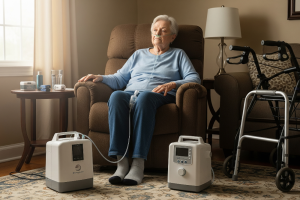 Chronic Obstructive Pulmonary Disease (COPD) is a progressive lung condition that significantly impacts the quality of life for millions of individuals worldwide. Characterized by persistent respiratory symptoms and airflow limitation, COPD encompasses two primary conditions: chronic bronchitis and emphysema. This article delves into the symptoms, diagnostic methods, and treatment options available for COPD, providing a comprehensive overview for patients and caregivers alike.
Chronic Obstructive Pulmonary Disease (COPD) is a progressive lung condition that significantly impacts the quality of life for millions of individuals worldwide. Characterized by persistent respiratory symptoms and airflow limitation, COPD encompasses two primary conditions: chronic bronchitis and emphysema. This article delves into the symptoms, diagnostic methods, and treatment options available for COPD, providing a comprehensive overview for patients and caregivers alike.
Symptoms of COPD
Common Symptoms
The symptoms of COPD can vary in intensity and may worsen over time. Early detection is crucial for effective management. Common symptoms include:
-
- Shortness of Breath: Often experienced during physical activities, this symptom can progress to occur even at rest as the disease advances.
- Chronic Cough: A persistent cough that may produce mucus is a hallmark of COPD. This cough can be more pronounced in the morning.
- Sputum Production: Individuals may notice an increase in mucus production, which can be clear, white, yellow, or green.
- Wheezing: A whistling sound during breathing, particularly when exhaling, can indicate narrowed airways.
- Chest Tightness: Many patients report a feeling of constriction in the chest, which can be uncomfortable and distressing.
Exacerbations
Exacerbations are episodes where symptoms worsen significantly, often triggered by infections, air pollution, or other environmental factors. These episodes can lead to increased breathlessness, coughing, and sputum production, necessitating immediate medical attention.
Impact on Daily Life
The symptoms of COPD can severely affect daily activities, leading to limitations in physical exertion and social interactions. Patients may find themselves avoiding activities they once enjoyed, which can contribute to feelings of isolation and depression.
Diagnosis of COPD
Initial Assessment
Diagnosing COPD begins with a thorough evaluation by a healthcare professional. This includes:
-
- Medical History: A detailed account of symptoms, smoking history, exposure to pollutants, and family history of lung diseases.
- Physical Examination: A healthcare provider will conduct a physical exam, listening to the lungs and checking for signs of respiratory distress.
Spirometry Testing
The cornerstone of COPD diagnosis is spirometry, a pulmonary function test that measures lung function. Key aspects include:
-
- Forced Expiratory Volume (FEV1): This measures how much air a person can forcefully exhale in one second.
- Forced Vital Capacity (FVC): This measures the total amount of air exhaled after taking a deep breath.
- FEV1/FVC Ratio: A ratio of less than 0.7 indicates airflow limitation, confirming a diagnosis of COPD.
Additional Diagnostic Tools
In addition to spirometry, other tests may be employed to assess lung function and rule out other conditions:
-
- Chest X-ray: While not definitive for COPD, it can help exclude other lung diseases.
- CT Scan: Provides detailed images of the lungs, helping to identify emphysema or chronic bronchitis.
- Arterial Blood Gas Analysis: Measures oxygen and carbon dioxide levels in the blood, indicating how well the lungs are functioning.
Treatment Options for COPD
Lifestyle Modifications
The first step in managing COPD is making lifestyle changes, particularly smoking cessation. Quitting smoking is the most effective way to slow disease progression and improve lung function. Additional lifestyle modifications include:
-
- Avoiding Pollutants: Reducing exposure to secondhand smoke, air pollution, and occupational hazards can help manage symptoms.
- Regular Exercise: Engaging in physical activity can improve overall health and lung function. Tailored exercise programs can enhance endurance and strength.
Pharmacological Treatments
Medications play a crucial role in managing COPD symptoms and preventing exacerbations. Treatment plans are often tailored based on the severity of the disease:
-
- Bronchodilators: These medications relax the muscles around the airways, making breathing easier. They can be short-acting for immediate relief or long-acting for daily management.
- Inhaled Corticosteroids: These help reduce inflammation in the airways and are often used in combination with bronchodilators for patients with frequent exacerbations.
- Phosphodiesterase-4 Inhibitors: Medications like roflumilast can help reduce inflammation and prevent exacerbations in severe COPD cases.
Pulmonary Rehabilitation
Pulmonary rehabilitation is a comprehensive program that combines education, exercise training, and nutritional counseling. It aims to improve the overall well-being of individuals with COPD by:
-
- Enhancing physical fitness and endurance.
- Teaching effective breathing techniques.
- Providing strategies for managing symptoms and preventing exacerbations.
Oxygen Therapy
For patients with severe COPD and low oxygen levels, supplemental oxygen therapy may be necessary. This treatment can improve quality of life and prolong survival by ensuring adequate oxygen supply to the body.
Surgical Interventions
In certain cases, surgical options may be considered for individuals with severe COPD:
-
- Lung Volume Reduction Surgery: This procedure removes damaged lung tissue, allowing healthier lung areas to function more effectively.
- Lung Transplantation: For select patients, a lung transplant may be an option, significantly improving quality of life.
Managing Exacerbations
Recognizing Exacerbations
Patients and caregivers should be aware of the signs of exacerbations, which may include:
-
- Increased shortness of breath.
- Changes in sputum color or volume.
- Worsening cough or chest tightness.
Immediate Actions
If an exacerbation is suspected, it is essential to seek medical attention promptly. Treatment may involve:
-
- Short-term Use of Corticosteroids: To reduce inflammation and improve breathing.
- Antibiotics: If a bacterial infection is suspected.
- Increased Use of Bronchodilators: To relieve symptoms quickly.
Long-term Management Strategies
Regular Follow-ups
Ongoing monitoring and follow-up appointments with healthcare providers are vital for managing COPD effectively. Regular assessments can help track disease progression and adjust treatment plans as needed.
Vaccinations
Vaccinations play a crucial role in preventing respiratory infections that can exacerbate COPD symptoms. Patients should receive:
-
- Influenza Vaccine: Annually to reduce the risk of flu-related complications.
- Pneumococcal Vaccine: To protect against pneumonia, which can be particularly dangerous for individuals with COPD.
Support Systems
Living with COPD can be challenging, and having a strong support system is essential. Patients are encouraged to:
-
- Join Support Groups: Connecting with others facing similar challenges can provide emotional support and practical advice.
- Engage Family and Friends: Involving loved ones in the management plan can enhance motivation and adherence to treatment.
Chronic Obstructive Pulmonary Disease is a complex condition that requires a multifaceted approach to diagnosis and treatment. By understanding the symptoms, engaging in proactive management, and utilizing available resources, individuals with COPD can lead fulfilling lives despite their diagnosis. Early detection and intervention are key to improving outcomes and enhancing the quality of life for those affected by this chronic lung disease.
Our Medical Memberships Cover COPD Care
Direct Primary Care (DPC) is a model of care where the patient pays an upfront monthly membership fee for high-quality and low-cost primary care. This means no surprise fees or being billed differently for sick visits versus wellness visits. This model is accessible to all. The focus of Direct Primary Care is ongoing wellness and prevention to prevent unnecessary hospitalizations or costly visits to the ER for primary care services.
> Learn More About Our Medical Memberships
Contact Us (727-312-1262) To Learn More!
—
 About Honeybee Holistic Health
About Honeybee Holistic Health
Honeybee Holistic Health strongly believes in a holistic, organic, and integrative model of care where the patient is the center of all decisions. Our approach is to empower each one of our patients to heal themselves and to make informed, autonomous decisions in their plan of care. This is approached by integrating modern medicine with well-studied homeopathic treatment options when appropriate.
> Learn More